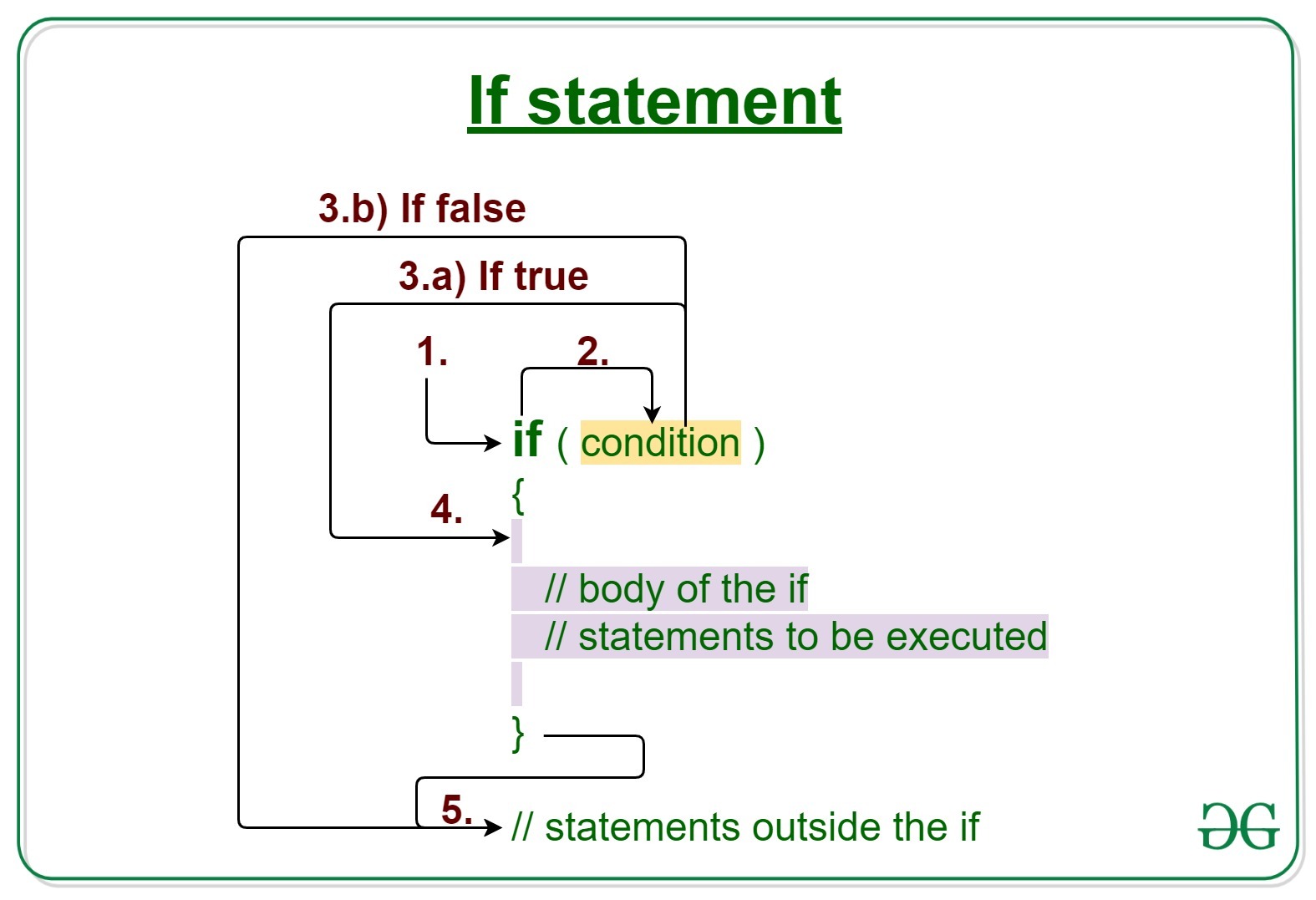Java if statement with Examples
Last Updated :
22 Mar, 2023
Decision Making in Java helps to write decision-driven statements and execute a particular set of code based on certain conditions.
The Java if statement is the most simple decision-making statement. It is used to decide whether a certain statement or block of statements will be executed or not i.e if a certain condition is true then a block of statement is executed otherwise not.

Syntax:
if(condition)
{
// Statements to execute if
// condition is true
}
Working of if statement:
- Control falls into the if block.
- The flow jumps to Condition.
- Condition is tested.
- If Condition yields true, goto Step 4.
- If Condition yields false, goto Step 5.
- The if-block or the body inside the if is executed.
- Flow steps out of the if block.
Flowchart if statement:

Operation: The condition after evaluation of if-statement will be either true or false. The if statement in Java accepts boolean values and if the value is true then it will execute the block of statements under it.
Note: If we do not provide the curly braces ‘{‘ and ‘}’ after if( condition ) then by default if statement will consider the immediate one statement to be inside its block.
For example:
if(condition)
statement1;
statement2;
// Here if the condition is true, if block will consider the statement
// under it, i.e statement1, and statement2 will not be considered in the if block, it will still be executed
// as it is not affected by any if condition.
Example 1:
Java
class IfDemo {
public static void main(String args[])
{
int i = 10;
if (i < 15)
System.out.println("10 is less than 15");
System.out.println("Outside if-block");
}
}
|
Output
10 is less than 15
Outside if-block
Time Complexity: O(1)
Auxiliary Space: O(1)
Dry-Running Example 1:
1. Program starts.
2. i is initialized to 10.
3. if-condition is checked. 10<15, yields true.
3.a) "10 is less than 15" gets printed.
4. "Outside if-block" is printed.
Example 2:
Java
class IfDemo {
public static void main(String args[])
{
String str = "GeeksforGeeks";
int i = 4;
if (i == 4) {
i++;
System.out.println(str);
}
System.out.println("i = " + i);
}
}
|
Output
GeeksforGeeks
i = 5
Time Complexity: O(1)
Auxiliary Space: O(1)
Example no 3: (Implementing if else for Boolean values)
Input -
boolean a = true;
boolean b = false;
Program –
Java
public class IfElseExample {
public static void main(String[] args) {
boolean a = true;
boolean b = false;
if (a) {
System.out.println("a is true");
} else {
System.out.println("a is false");
}
if (b) {
System.out.println("b is true");
} else {
System.out.println("b is false");
}
}
}
|
Output
a is true
b is false
Explanation-
The code above demonstrates how to use an if-else statement in Java with Boolean values.
- The code starts with the declaration of two Boolean variables a and b, with a set to true and b set to false.
- The first if-else statement checks the value of a. If the value of a is true, the code inside the first set of curly braces {} is executed and the message “a is true” is printed to the console. If the value of a is false, the code inside the second set of curly braces {} is executed and the message “a is false” is printed to the console.
- The second if-else statement checks the value of b in the same way. If the value of b is true, the message “b is true” is printed to the console. If the value of b is false, the message “b is false” is printed to the console.
- This code demonstrates how to use an if-else statement to make decisions based on Boolean values. By using an if-else statement, you can control the flow of your program and execute code only under certain conditions. The use of Boolean values in an if-else statement provides a simple and flexible way to make these decisions.
Advantages of If else statement –
The if-else statement has several advantages in programming, including:
- Conditional execution: The if-else statement allows code to be executed conditionally based on the result of a Boolean expression. This provides a way to make decisions and control the flow of a program based on different inputs and conditions.
- Readability: The if-else statement makes code more readable by clearly indicating when a particular block of code should be executed. This makes it easier for others to understand and maintain the code.
- Reusability: By using if-else statements, developers can write code that can be reused in different parts of the program. This reduces the amount of code that needs to be written and maintained, making the development process more efficient.
- Debugging: The if-else statement can help simplify the debugging process by making it easier to trace problems in the code. By clearly indicating when a particular block of code should be executed, it becomes easier to determine why a particular piece of code is not working as expected.
- Flexibility: The if-else statement provides a flexible way to control the flow of a program. It allows developers to handle different scenarios and respond dynamically to changes in the program’s inputs.
Overall, the if-else statement is a fundamental tool in programming that provides a way to control the flow of a program based on conditions. It helps to improve the readability, reusability, debuggability, and flexibility of the code.
Related Articles:
- Decision Making in Java
- Java if-else statement with Examples
- Java if-else-if ladder with Examples
- Switch Statement in Java
- Break statement in Java
- return keyword in Java
Like Article
Suggest improvement
Share your thoughts in the comments
Please Login to comment...